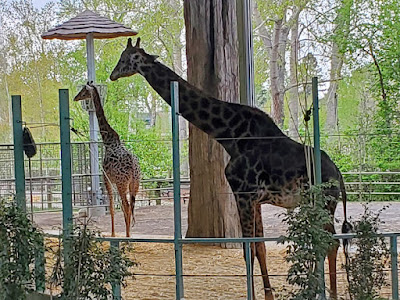 |
Hoodoos, near Drumheller, Alberta, Canada
|
Over the eons the Red Deer River has cut a valley into the
Alberta plains in Western Canada, revealing layers of rock going back to
dinosaur times. Wind and rain have carved some of these rocks into giant
mushroom shapes called hoodoos when the upper layer of rock erodes more slowly
than the layer beneath.
 |
Stairways lead to viewing platforms for the hoodoos.
|
In early May, my husband Art and I visited Alberta,
getting a close look at some of the hoodoos and taking a self-guided geology walk
near the Royal Tyrell Museum in Drumheller.
 |
Alberta wheat fields.
|
To get to Drumheller we drove an hour and a half from Calgary across the
Alberta wheat fields—an endless vista of golden plains dotted with the
occasional silo or homestead. Then suddenly, just before arriving at
the town of Drumheller, the road plunged down into the Red Deer River valley, almost as if
the earth had suddenly cracked open to show us the history of its insides.
 |
| Each layer of rock is a story from the past. White sandstone
was once sand at the bottom of a river. Grey-brown layers were once silt and
mud. Black is coal, formed by the remains of plants. Chemical reactions in
the buried sediments form the dark iron-stones. |
The Red Deer River Valley was formed by floodwaters from melting glaciers
during the last Ice Age, 10,000 to 15,000 years ago, and it has been eroding
ever since.
 |
Signs with history of the area are posted throughout the valley.
|
The black layers of the rock walls are coal. The coal mines that once drew
people to this valley are no longer operating. Other layers are filled with
dinosaur bones and other fossils of the Dinosaur Age. The fossil discoveries in
Alberta have been spectacular and many are on display at the Royal Tyrell Museum in
Drumheller. (The museum will be the subject of another blogpost.)
 |
A map of the trail and location of interpretive signs.
|
But just outside
the museum is the Badlands Interpretive Trail, a one-kilometer loop walk that
provides a close look at the local geology and information about the area--a good introduction or follow-up to visiting the museum.
 |
Crocuses blooming along the trail are a sign of spring.
|
The climate of the Red Deer River in the late Cretaceous, 72
million years ago, was warm and moist, like Florida today. Today, the valley is
seasonally warm and semi-arid. On the day we visited, in late May, the weather
was cool and overcast, ideal for taking a walk.
Along the trail numbered signs explained what we were seeing.
 |
| These small boulders made of igneous rock were brought from elsewhere and dropped
by a melting glacier. |
 |
Hoodoos like these on the museum trail are found throughout the badlands.
|
 |
| This fossilized tree stump from a giant redwood was part of a forest
that once grew here. |
Most of Alberta’s dinosaur remains are found in the Badlands
and river valleys where Cretaceous-aged sediments are exposed. Today, wind,
rainfall, and snow melt continue to erode the badlands, exposing more fossils
with each passing season. We did not see any fossil remains on our walk, but we
could imagine what the Earth was like millions of years ago when dinosaurs made
Alberta their home.
 |
Walking the dinosaur trail.
|














































